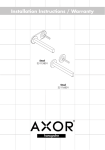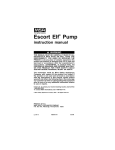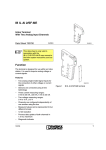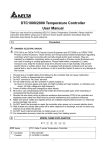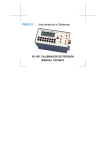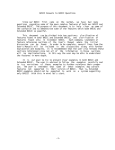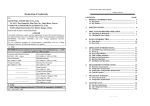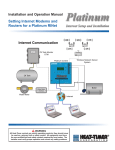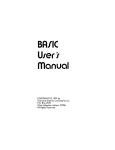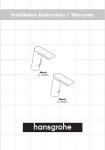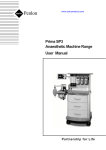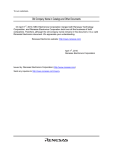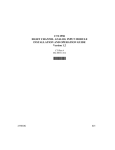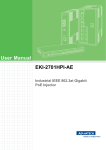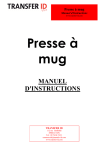Download 2559-RTD 8-Channel RTD Input Module
Transcript
CTI 2559-RTD EIGHT-POINT RTD MODULE INSTALLATION AND OPERATION GUIDE Version 1.2 CTI Part # 062-00337-012 062-00337-012 2559RTDIOG 062209 $25 Copyright © 2005 Control Technology Inc. All rights reserved. This manual is published by Control Technology Inc., 5734 Middlebrook Pike, Knoxville, TN 37921. This manual contains references to brand and product names that are trade names, trademarks, and/or registered trademarks of Control Technology Inc. Siemens® and Simatic® are registered trademarks of Siemens AG. Other references to brand and product names are trade names, trademarks, and/or registered trademarks of their respective holders. DOCUMENT DISCLAIMER STATEMENT Every effort has been made to ensure the accuracy of this document; however, errors do occasionally occur. CTI provides this document on an "as is" basis and assumes no responsibility for direct or consequential damages resulting from the use of this document. This document is provided without express or implied warranty of any kind, including but not limited to the warranties of merchantability or fitness for a particular purpose. This document and the products it references are subject to change without notice. If you have a comment or discover an error, please call us toll-free at 1-800-537-8398. REVISION HISTORY Version 1.0 Version 1.1 Version 1.2 12/13/04 01/05/05 11/12/08 06/22/09 Original Release Corrections made to Table 3.1 and Table 3.2 added. Corrections to 2 wire connection figure caption CTI 2559-RTD Installation and Operation Guide iii PREFACE 0B This Installation and Operation Guide provides installation and operation instructions for the CTI 2559-RTD Eight-Point Resistance Temperature Detector (RTD) Input Model for SIMATIC® 505 programmable controllers. We assume you are familiar with the operation of SIMATIC® 505 series programmable controllers. Refer to the appropriate SIMATIC® 505 user documentation for specific information on the SIMATIC® 505 programmable controllers and I/O modules. This Installation and Operation Guide is organized as follows: Chapter 1 provides an overview of the module. Chapter 2 covers installation and wiring. Chapter 3 is a guide to troubleshooting. The Model 2559-RTD 8-Pt RTD Module CTI 2559-RTD Installation and Operation Guide v USAGE CONVENTIONS 1B NOTE: Notes alert the user to special features or procedures. CAUTION: Cautions alert the user to procedures that could damage equipment. WARNING: Warnings alert the user to procedures that could damage equipment and endanger the user. CTI 2559-RTD Installation and Operation Guide vii TABLE OF CONTENTS 2B PREFACE........................................................................................................................................................... V USAGE CONVENTIONS .............................................................................................................................. VII TABLE OF CONTENTS................................................................................................................................. IX TABLE OF FIGURES ..................................................................................................................................... XI CHAPTER 1. OVERVIEW ...............................................................................................................................1 1.0. Product Summary ......................................................................................................................................1 1.1. Front Panel Description .............................................................................................................................1 1.2. Asynchronous Operation ...........................................................................................................................2 1.3. Immediate I/O ............................................................................................................................................3 1.4. Supported RTD Probes ..............................................................................................................................3 1.4.1. RTD Probe Type ...........................................................................................................................3 1.4.2. RTD Ohm Values .........................................................................................................................3 1.4.3. 2-Wire, 3-Wire, 4-Wire ................................................................................................................3 1.5. Direct Resistive Device Input ....................................................................................................................3 1.6. Digital Word Map......................................................................................................................................4 1.7. RTD to Digital Conversion........................................................................................................................4 1.7.1. Engineering Unit...........................................................................................................................4 1.7.2. Scaled Integer Data .......................................................................................................................4 1.8.Module Addressing ...................................................................................................................................5 1.9. Error Reporting ..........................................................................................................................................5 CHAPTER 2. INSTALLATION .......................................................................................................................6 2.1. Planning the Installation ............................................................................................................................6 2.1.1. Calculate the I/O Base Power Budget...........................................................................................6 2.1.2. Input Signal Wiring ......................................................................................................................6 2.1.3. Selecting RTDs .............................................................................................................................7 2.1.3.1 Four-wire RTDs ...........................................................................................................7 2.1.3.2 Three-wire RTDs..........................................................................................................7 2.1.3.3 Two-wire RTDs............................................................................................................7 2.2. Unpacking the Module ..............................................................................................................................7 2.3. Configuring the Module ............................................................................................................................8 2.3.1. Selecting the Input Resistance ......................................................................................................9 2.3.2. Selecting RTD Probe Type ...........................................................................................................9 2.3.3. Selecting the WX Word Input Format ..........................................................................................9 2.3.4. Selecting Lead Resistance Compensation ..................................................................................10 2.3.5. Selecting the Error Format..........................................................................................................10 2.3.6. Selecting Digital Filtering...........................................................................................................10 2.3.7. Selecting Run or Calibration Mode ............................................................................................10 2.4. Inserting the Module into the I/O Base....................................................................................................10 2.5. Wiring the Input Connector .....................................................................................................................10 2.5.1. Connecting RTD Input Wiring ...................................................................................................11 2.5.2. Terminating the Wire Shielding .................................................................................................13 2.6. Installing the Screw Terminal Connector ................................................................................................14 CTI 2559-RTD Installation and Operation Guide ix 2.7. Calibrating the Module ........................................................................................................................... 15 2.7.1 Calibration Requirements ............................................................................................................ 15 2.7.2. Calibration Connector Wiring Instructions ................................................................................ 15 2.7.3. Calibration Procedure................................................................................................................. 15 2.7.4. Calibration Process..................................................................................................................... 16 2.7.5. Calibration Troubleshooting ...................................................................................................... 16 2.8. Checking Module Operation ................................................................................................................... 16 CHAPTER 3. TROUBLESHOOTING .......................................................................................................... 18 HARDWARE SPECIFICATIONS ................................................................................................................. 21 APPENDIX A. COMPATIBILITY WITH SIEMENS® 505-7038 .............................................................. 23 APPENDIX B. RTD TEMPERATURE VS RESISTANCE ........................................................................ 25 LIMITED PRODUCT WARRANTY ............................................................................................................. 27 REPAIR POLICY ............................................................................................................................................ 28 x CTI 2559-RTD Installation and Operation Guide TABLE OF FIGURES 3B Figure 1.1 CTI 2559-RTD Front Panel ................................................................................................. 2 Figure 1.2 Word Input to the PLC ....................................................................................................... 4 Figure 1.3 Digital Representation of Input Temperature Change ..................................................... …4 Figure 2.1 Configuration Dipswitch Location and Function ................................................................ 9 Figure 2.2 Screw Terminal Connector Wiring .................................................................................... 11 Figure 2. 3 RTD Sensor Wiring .......................................................................................................... 12 Figure 2.4 Terminating the Wire Shielding ....................................................................................... 13 Figure 2.5 Input Connector Assembly ................................................................................................ 14 Figure 2.6 Calibration Connector Wiring Diagram ............................................................................ 15 Figure 2.7 Example I/O Configuration Chart..................................................................................... 17 Figure 3.1 Troubleshooting Matrix... .................................................................................................. 18 LIST OF TABLES 4B Table 1.1 RTD Types ........................................................................................................................... 3 Table 1.2 Supported RTD Ohm Values ................................................................................................ 3 Table 1.3 Module Addressing Configurations .................................................................................. …5 Table 2.1 Dipswitch Assignments......................................................................................................... 8 Table 2.2 Precision Resistor Values for Calibration .......................................................................... 14 Table 3.1 Problem Codes and Messages Reported for 3 Wire Mode ................................................ 19 Table 3.2 Problem Codes and Messages Reported for 4 Wire Mode ................................................ 20 CTI 2559-RTD Installation and Operation Guide xi CHAPTER 1. OVERVIEW 5B 1.0. Product Summary 13B The CTI 2559-RTD Eight-Channel RTD Module is a member of Control Technology’s family of I/O modules compatible with the SIMATIC® 505 programmable controllers. It is a single-wide module that is compatible with two-, three-, and four-wire RTDs, with automatic lead wire resistance compensation for three-wire and four-wire RTDs. The 2559-RTD pulses a small amount of current through the RTD. The module measures the voltage generated by the current through the RTD and determines the resistance. Lookup tables relating temperature to resistance for different RTD probes are used to determine the temperature. 1.1. Front Panel Description Active LED Figure 1.1 CTI 2559-RTD Front Panel The Active LED will be illuminated when the module is functioning normally. If the Active LED is not lit, or if it is blinking the module is not working properly. Refer to Chapter 3 for troubleshooting. 1.2. Asynchronous Operation The module operates asynchronously with respect to the PLC (a scan of the PLC and input sampling of the module do not occur at the same time). Instead, the module will translate all RTD inputs in one module update (25 milliseconds maximum) and store the translated words in buffer memory. The PLC retrieves the stored words from the module buffer memory at the start of the I/O scan. 2 CTI 2559-RTD Installation and Operation Guide 1.3. Immediate I/O 14B The 2559-RTD has been tested and is fully compatible with the immediate input instruction for the SIMATIC® 545 and 555 PLCs. 1.4. Supported RTD Probes 15B 1.4.1. RTD Probe Types 26B Seven RTD probe types from standard RTD materials are supported as inputs to the 2559-RTD. The types supported are listed in Table 1.1. RTD types are selectable with dipswitches 4, 5, and 6 on switch block 1. 1.4.2. RTD Ohm Values 27B RTD types are supported in the following ohm values listed in Table 1.2. These values are selectable with dipswitches 1, 2, and 3 on switch block 1. RTD Type Ohms (Ω) 0.0 Cº Platinum 0.003850 Platinum 0.003916 Platinum 0.003902 Platinum 0.003920 Copper 0.004274 Nickel 0.006720 Nickel 0.006178 Table 1.1 RTD Types 100 Ω 120 Ω 130 Ω 200 Ω 500 Ω 1000 Ω 10 Ω 9.03 Ω Table 1.2 Supported RTD Ohm Values 1.4.3. 2-Wire, 3-Wire, and 4-Wire RTDs The 2559-RTD supports 2-wire, 3-wire, and 4-wire RTD probes that are selectable on dipswitch 1 on switch block 2. Position 0 is for 4-wire RTDs and position 1 selects 2- and 3-wire RTDs. 1.5. Direct Resistive Device Input 16B Direct ohm inputs to the module are supported for measuring resistive loads or with resistive sensors. Resistance measurements are made by setting dipswitches 7 and 8 on switch block 1 to Ohms (Ω). Dipswitches 1, 2, and 3 on switch block 1 are used to select the order of magnitude of the resistance to be measured (10 Ω or 1k Ω). By selecting 10 Ω Ohm, values are reported as ohms x 100 to the PLC and selecting 1k Ω reports ohms x 10. CTI 2559-RTD Installation and Operation Guide 3 1.6. Digital Word Map 17B RTD inputs are translated into 16-bit digital words. Figure 1.2 illustrates the WX word format represented in the PLC. 1 0 Sign Bit MSB 2 0 3 0 4 0 5 0 6 1 LSB 7 8 9 10 11 12 13 14 15 16 0 0 0 0 0 0 0 0 0 0 15 Bits Reporting Data Figure 1.2 Word Input to the PLC 1.7. RTD Input to Digital Conversion 18B 1.7.1. Engineering Units 28B Temperature can be reported in Fahrenheit or Celsius degrees times 10 as a word input. As an example, the following Figure 1.2 illustrates the effects of a change in input level going from 0 to 102.4oF in the RTD Input Mode. Example 1: 0.0oF = (Digital Word (WX))/10 1 0 + MSB 2 0 . 3 0 . Example 2: 4 0 . 5 0 . 6 0 . 7 0 . 8 0 . 9 0 . LSB 10 11 12 13 14 15 16 0 0 0 0 0 0 0 . 32 16 8 4 2 1 102.4oF = (Digital Word (WX))/10 1 0 + MSB 2 3 0 0 . . 4 0 . 5 0 6 7 1 0 1024 8 0 . 9 0 . LSB 10 11 12 13 14 15 16 0 0 0 0 0 0 0 . 32 16 8 4 2 1 Figure 1.3 Digital Representation of Input Temperature Change 1.7.2. Scaled Integer Data 29B When the data format is selected as Integer, the full temperature range of the RTD is scaled as an unsigned integer from 0 to 32000. The following formulas may be used to calculate the scaled integer value for temperature. Temperature: 4 Scaled Integer = (measured temp - min temp) / (max temp - min temp) x 32000 ex: the scaled integer offset at 0oC for a 100Ω Pt RTD is: Scaled integer = (0 - (-199.8)) / (849 - (-199.8)) x 32000 = 6091 CTI 2559-RTD Installation and Operation Guide 1.8. Module Addressing 19B The 2559-RTD module can be configured as an 8 WX or 16 WX word module. This is selectable using dipswitch 2 on switch block 2. Table 1.3 lists the WX configurations for the 2559-RTD module. In 16 WX mode, errors are reported in Words 9-16 for inputs 1-8. Format WX16 Inputs 8 WX8 8 I/O Values WX 1-8 Input Points 1-8 WX 9-16 Separate Error Words WX 1-8 Input Points 1-8, upscale errors Table 1.3 Module Addressing Configurations 1.9. Error Reporting If the module is set for 8WX and an error occurs, the input data are replaced by an error word and that input ceases updating. You must correct the error condition before the input resumes updating. If the module is set for 16WX word inputs and an error occurs, the last valid data are frozen. An error word is reported in one of the last eight inputs as shown in Table 3.2 This allows the error to be detected in your application program without immediately affecting controller operation. Errors are reported as values greater than or equal to 32752. Refer to Table 3.2 for error code descriptions. CTI 2559-RTD Installation and Operation Guide 5 CHAPTER 2. INSTALLATION 6B The installation of the Eight-Point RTD Module involves the following steps: 1. 2. 3. 4. 5. Planning the installation, Unpacking and configuring the module. Wiring the input connector. Inserting the module into the I/O base. Checking module operation. The steps listed above are explained in detail in the following pages. 2.1. Planning the Installation 20B Planning is the first step in the installation of the module. This involves calculating the I/O base power budget and routing the input signal wiring to minimize noise and selecting RTDs. The following sections discuss these important considerations. 2.1.1. Calculating the I/O Base Power Budget 30B The Model 2559-RTD requires 2.8 watt (maximum) of +5 VDC power from the I/O base. Use this value to verify that the base power supply is not exceeded. 2.1.2. Input Signal Wiring 31B Input signal wiring can be 2, 3 or 4-wire twisted shielded cable. The cable can be stranded or solid 14-24 AWG wire. Standard practices usually require that all shields be tied together and grounded at a single point. These guidelines will minimize noise problems when installing the module. • Always use the shortest possible cables • Avoid placing low voltage wire parallel to high-energy wire (if the two wires must meet, cross them at a right angle) • Avoid bending the wire into sharp angles • Use wire raceways or conduit for wire routing • Avoid placing wires on any vibrating surface • Use a 4-wire conductor with shielding and tie shield to ground. • Terminating the shield to earth ground at the PLC is preferred. • Never terminate the shield at both the RTD and PLC. 2.1.3 Selecting RTDs 32B RTDs should be selected to optimize the accuracy of temperature measurements over the range of temperatures to be measured, survive in the environmental conditions where it will operate, and be appropriately packaged to meet the mounting requirements. Platinum RTD probes are the most stable material that is commonly used and provide long-term accuracy. Refer to manufacturer’s recommendation to determine the best RTD for a particular application. 6 CTI 2559-RTD Installation and Operation Guide 2.1.3.1 Four-wire RTDs Four-wire RTDs give the best accuracy and are not affected by changes in terminal, wire, or contact impedance. Wire type and temperature coefficients do not affect accuracy, and wire impedance is relatively unimportant for the Sense+ and Sense- wires. 2.1.3.2 Three-wire RTDs 3B Three-wire RTDs are less accurate than the 4-wire RTDs. The contact resistances cannot be compensated for and could become significant. The following guidelines will minimize errors. o Minimize the difference in resistance between the Source and Return o Resistive differences cause offsets. o Wire the Sensor as illustrated in Figure 2.3 o Restrict the lead resistance to less than 50Ω. o Source and Return wires should have same temperature coefficient. 2.1.3.3 Two-wire RTDs 34B Two-wire RTDs can be used if accuracy is non-critical. Lead resistance and lead-wire temperature drift cause temperature offsets . 2.2. Unpacking the Module Open the shipping carton and remove the special anti-static bag which contains the module. After discharging any static build-up, remove the module from the static bag. Do not discard the static bag. Always use this bag for protection against static damage when the module is not inserted into the I/O backplane. CAUTION: HANDLING STATIC SENSITIVE DEVICES The components on the Model 2559-RTD module printed circuit card can be damaged by static electricity discharge. To prevent this damage, the module is shipped in a special anti-static bag. Static control precautions should be followed when removing the module from the bag, when opening the module, and when handling the printed circuit card during configuration. CTI 2559-RTD Installation and Operation Guide 7 2.3 Configuring the Module The 2559-RTD is configured using two switch blocks located at the top front of the module. Table 2.1 lists the features and options associated with the dipswitches and the default configuration of the module. NOTE: Configuration applies to ALL CHANNELS. NOTE: Shipping Configuration 100Ω Pt 0.003850 °F × 10 3-Wire 16WX 60Hz Digital Filtering Table 2.1 Dipswitch Assignments Feature Options Assembly Switches Default Input resistance at 0°C One of eight values for input resistance at 0°C. Also selects the reporting scale for direct Ω input. S1 1, 2, and 3 Probe type One of 7 RTD curves. S1 4, 5, and 6 WX input Format °F × 10 °C × 10 ohms x 10 ohms x 100 scaled integer. S1 7 and 8 °F × 10 Lead resistance Compensation 2-, 3-, or 4-wire. S2 1 3-wire Error format 16WX/separate error words or 8WX/upscale errors (32752 and above). S2 2 16WX Input filtering 50 or 60 Hz. S2 3 60 Hz Digital filtering Enable/Disable S2 4 Enabled Calibration Run or calibration mode. S2 8 Run 100 Ω Pt 0.003850 DIN Figure 2.1 shows the location of the two switch-blocks on the module with a detailed diagram illustrating the location and function of the dipswitches used to configure the module. 8 CTI 2559-RTD Installation and Operation Guide Figure 2.1 Dipswitch Locations and Function 2.3.1 Selecting the Input Resistance. Dipswitches 1, 2, and 3 are used to select RTD resistance for the probe types. When measuring ohm (Ω) values, select 1k Ω, which reports ohms x 10, or 10 Ω, when measuring resistive values less than 100 Ω. These values are reported as ohms x 100. Refer to Figure 2.1. 2.3.2. Selecting RTD Probe Type. Seven RTD material types are selectable using dipswitches 4, 5, and 6 on switch block 1. Refer to Figure 2.1. 2.3.3. Selecting WX Word Input Format. Dipswitches 7 and 8 on switch block 1 are used to select the format that data is presented in the WX input word for the 8 channels. Refer to Section 1.7.1 for engineering format and Section 1.7.2 for scaled integer format. Reporting ohm Ω resistive values is also selected using dipswitches 7 and 8 on switch block 1. Data is presented as ohms x 10 or 100, °F x 10, °C x 10, or as a scaled integer. CTI 2559-RTD Installation and Operation Guide 9 2.3.4. Selecting Lead Resistance Compensation. Dipswitch 1 on switch block 2 is used to select the type of lead compensation. Two- and three-wire compensation is selected with a 1 and 4-wire with a 0. 2.3.5. Selecting the Error Formatting. Dipswitch 2 on switch block 2 is used to select how errors are reported. With the dipswitch in the 1 position the module logs into the base as a WX16 module. Errors are reported in words WX 9-16. In the zero position the module logs into the base as a WX8 module. When errors occur, error words are written to the corresponding data word and the error condition must be cleared before data is again reported. 2.3.6. Selecting Digital Filtering. Digital Filtering is selected by positioning dipswitch 4 on switch block 2 in the 1 position. Selecting digital filtering will limit data fluctuations due to signal noise. 2.3.7. Selecting Run or Calibration Mode. Dipswitch 8 on switch-block two is in the 1 position for normal operation. To calibrate the module, put dipswitch 8 in the 0 position. 2.4. Inserting the Module into the I/O Base 21B Avoid installing the 2559-RTD in a slot adjacent to a high-energy switching module. WARNING: Turn power off to base before installing or removing the module. Insert the module into the I/O base by carefully pushing the module into the slot. When the module is fully seated in the slot and backplane connector, tighten the captive screws at the top and bottom to hold the module in place. To remove the module from the I/O base, loosen the captive screws then remove the module from the I/O base. Be careful not to damage the edge card at the back of the module when inserting or removing the module. 2.5. Wiring the Input Connectors 2B Input signals are accepted through a standard 40 terminal connector located on the front of the module. Figure 2.2 illustrates how the wiring is connected to the front connector via recessed screw terminals. The screw terminals can accept wire sizes up to single stranded 14-gauge wire. The actual size used depends on the RTD wire providing the input signal. To assign an input to a specific channel, locate the appropriate channel position on the screw terminal connector as shown in the Figure 2.4 and connect wiring. 10 CTI 2559-RTD Installation and Operation Guide Figure 2.2 Screw Terminal Connector Wiring 2.5.1. Connecting RTD Input Wiring 35B For RTD input circuits, connect the RTD wires to the screw terminals on the front connector. Refer to Figure 2.2 and Figure 2.3 to determine the correct channel and proper wiring connections for 2-wire, 3-wire, and 4wire RTDs. After the wires are inserted in the correct terminals, tighten the screws using CARE not to overtighten and strip the connector terminal. Repeat this procedure for the remaining RTD input channels. CTI 2559-RTD Installation and Operation Guide 11 Two-wire, no lead compensation Set module to 2/3 wire mode Figure 2.3 RTD Sensor Wiring 12 CTI 2559-RTD Installation and Operation Guide 2.5.2. Terminating the Wire Shielding 36B Conductor shielding must be connected to earth ground. Terminating the shield to earth ground at the PLC is preferred. If terminating the shield at the PLC, follow procedures illustrated in Figure 2.4. NEVER terminate the shield at both the RTD and PLC. Figure 2.4 Terminating the Wire Shielding CTI 2559-RTD Installation and Operation Guide 13 2.6. Installing the Screw Terminal Connector 23B When all the input signal wires are connected to the screw terminal connector, carefully install the connector on the front of the module (see Figure 2.5). Figure 2.5 Input Connector Assembly 2.7. Calibrating the Module 24B The 2559-RTD is calibrated at the factory and needs no calibration when installed. The module should be calibrated yearly for best accuracy. If the module operates in an environment where the ambient temperature cycles outside the range of 20 o C to 30o C, more frequent calibration may be required. Also, if the ambient temperature is constantly outside the range of 20 o C to 30o C, calibration at the ambient temperature may improve accuracy. NOTE: The 2559-RTD Input Module is calibrated at the factory for initial installation. Further calibration may be required depending on the environment in which the module and/or the RTD operates.. 2.7.1 Calibration Requirements 37B Calibration of the 2559-RTD is accomplished by the use of a standard 505 connector (CTI P/N 4-565) and four precision resistors. Make sure the resistors meet or exceed the specifications in Table 2.2. Table 2.2 Precision Resistor Values for Calibration Ohms 20.00 402.0 2000.0 4020.0 14 Tolerance 0.001% 0.001% 0.001% 0.001% Temperature Coefficient 25 ppm/oC 10 ppm/oC 10 ppm/oC 10 ppm/oC CTI 2559-RTD Installation and Operation Guide 2.7.2 Calibration Connector Wiring Instructions Precision resistor values for calibration are installed on a specially wired 40-Pin connector which MUST be in place prior to initiating the calibration. The connector is wired as follows: o Channel 1 o Channel 2 o Channel 3 o Channel 4 o Channel 5 o Channel 6 o Channel 7 o Channel 8 Four Wire 2000.0 Ohm Resistor Short all four terminals Four Wire 402.0 Ohm Resistor Short all four terminals Four Wire 20.00 Ohm Resistor Short all four terminals Four Wire 4020.0 Ohm Resistor Short all four terminals. (500 Ohm Range) (100 Ohm Range) (10 Ohm Range) (1K Ohm Range) The calibration connector wiring for channels 1-4 is illustrated in Figure 2.6. Channels 5-8 are wired similarly, just substitute resistor values from the preceding list. Figure 2.6 Calibration Connector Wiring Diagram 2.7.3 Calibration Procedure 38B The following steps are needed to ensure proper calibration of the module: 1. Remove power from the 505 rack that contains the RTD module. 2. Remove the field wiring connector from the RTD module. 3. Remove the module from the rack. 4. Set dipswitch 8 SW2 to the Cal (0) position. 5. Install the precision resistors per Figure 2.6. 6. Reinsert the module into the rack. 7. Apply power to the rack. The module LED will begin to blink slowly and, after around 3 minutes, the LED will begin to blink rapidly to indicate completion of the calibration. 8. Work through the above steps in a backward progression to return the module to operation. CTI 2559-RTD Installation and Operation Guide 15 2.7.4 Calibration Process 39B During the calibration process, the front panel LED will blink at a rate indicating the Calibration Phase. 1. 2. 3. 4. 5. 6. 0.25 Hz - Phase 1 Acquiring 2000 Ohm data 0.5 Hz - Phase 2 Acquiring 0 Ohm data (for 200/500 Ohm Range) 1 Hz - Phase 3 Acquiring 402 Ohm data 2 Hz - Phase 4 Acquiring 20 Ohm data 4 Hz - Phase 5 Acquiring 4020 Ohm data Solid - Calibration complete - set Run/Calibrate switch to Run and restart module. The calibration process is terminated in one of three ways. 1. A successful completion leaves the Active LED SOLID ON. Power off the base, remove the module. Return dipswitch 8 on SW 2 to the Run position, reinstall the module and power up the base. 2. An EEPROM write failure leaves the Active LED SOLID OFF. 3. Any out of range condition detected during the acquisition phase causes the Active LED to blink out Morse Code S - O - S, i.e. three short flashes, three long flashes, and three short flashes. A pause occurs, then the pattern repeats. The calibration failed but the existing calibration in the module is UNAFFECTED. 2.7.5. Calibration Troubleshooting 40B If the LED does not follow the slow-fast blinking that describes a successful calibration, one or more of the calibration resistors may be out of range. Call CTI if module does not properly calibrate after re-checking the procedure and calibration connector. 2.8. Checking Module Operation 25B First turn on the base power. If the module diagnostics detect no problems, the status indicator on the front of the module will be solid red. If the status indicator does not light, begins blinking (or goes out during operation), the module has detected a failure. For information on viewing failed module status, refer to your SIMATIC® TISOFT user manual. To diagnose and correct a module failure, refer to the next section on troubleshooting. You must also check that the module is configured in the memory of the PLC. This is important because the module will appear to be functioning regardless of whether it is communicating with the PLC. To view the PLC memory configuration chart listing all slots on the base and the inputs or outputs associated with each slot, refer to your SIMATIC® TISOFT Programming Manual. An example chart is shown in the following figure. 16 CTI 2559-RTD Installation and Operation Guide I/O Module Definition for Channel…….1 Base..…..00 Number of Bit and Word I/O I/O Address Slot 1 2 . . 15 16 0001 0000 . . 0000 0000 X 00 00 . . 00 00 Y 00 00 . . 00 00 WX 08 00 . . 00 00 WY 00 00 . . 00 00 Special Function NO NO . . NO NO Figure 2.7 Example I/O Configuration Chart In this example, the 2559-RTD module is inserted in slot 1 in I/O base 0 and configured as a WX8 word module. Data for channel 1 appears in word location WX1, data for channel 2 appears in word location WX2, etc. For your particular module, look in the chart for the number corresponding to the slot occupied by the module. If word memory locations appear on this line, then the module is registered in the PLC memory and the module is ready for operation. If the line is blank or erroneous, re-check the module to ensure that it is firmly seated in the slots. Generate the PLC memory configuration chart again. If the line is still incorrect, contact your local distributor or CTI at 1800-537-8398 for further assistance. NOTE: Refer to Hewlett-Packard Applications Note 290 or Omega Temperature Handbook, Volume 26, Section T, for “practical RTD measurement” applications. CAUTION: For proper operation, ensure that the 2559-RTD and the RTD wires are not subjected to drafts or large temperature gradients during operation. NOTE: In the event the 2559-RTD detects an onboard module failure, the module will assert the module fail line and report the module failure in the I/O Status Word, which is reported to the PLC. CTI strongly recommends the user application monitor the I/O Module Status Words which are Status Words 1126 and apply to SIMATIC® Controllers TI/545, TI/555, TI/560 & 565, and the TI/575. The I/O Module Status Word can be used to report a module failure for an I/O Module in any of the 505 I/O slots. Please refer to Siemens® SIMATIC® 505 Programming Reference Manual for more information. If a module failure is reported by the status word, the module should be replaced with a working unit and the failed module sent in for repair. CTI 2559-RTD Installation and Operation Guide 17 CHAPTER 3. TROUBLESHOOTING 7B If the module provides improper readings or the Active LED status indicator is not on, use the following chart to determine the appropriate corrective action. Symptom Active LED is not lit. U Probable Cause Base or PLC power is off. Corrective Action Turn base or PLC on. Module has failed. Return to CTI for repair. Blown fuse. Measure F1 for continuity. Return to CTI if Blown Return to CTI for calibration or recalibrate per manual. U U Active LED is blinking. No calibration data. Incorrect inputs. Wrong addresses for word input. Check program for correct word input addresses. Not logged in. Read I/O configuration. Incorrectly calibrated. Return the module to CTI for calibration or recalibrate according to instructions. Input does not work with PID loop or analog alarm block. Value is not reported as integer 0-32,000. Select INTEGER format with dipswitches 7 and 8 on SW1. Value is too large. Temperature is reported to PLC as value x10. Divide value by 10 in PLC. Incorrect values to PLC. (values off by 10-15 degrees) DIP switch not set in correct position. Verify position of dipswitches. Wrong RTD type selected by dipswitches. Verify position of dipswitches. Unbalanced lead wires Check lead resistance. Signal wire noise Refer to Section 2.1.2 Figure 3.1 Troubleshooting Matrix When it is inconvenient to visually check the status indicator, use the TISOFT “Display Failed I/O” or “Show PLC Diagnostics” support functions. If after consulting the chart above, you are unable to diagnose the problem, contact your local distributor or CTI at 1-800-537-8398 for further assistance. 18 CTI 2559-RTD Installation and Operation Guide Table 3.1 Problem Codes and Messages Reported in Three Wire Mode Signed Integer 32767 Hex Code 7FFF 32766 7FFE Input underrange RTD input is below expected range 32765 7FFD Input overrange RTD input is above expected range 32764 7FFC Not Used 32763 7FFB Sense short 32762 7FFA Input not wired 32761 32760 32759 7FF9 7FF8 7FF7 32758 7FF6 32757 32756 32755 32754 7FF5 7FF4 7FF3 7FF2 32753 7FF1 32752 7FF0 Source open Not used Not used Source-to-Return overrange Not used Not used Not used Not used Invalid RTD Type selected Not used 3 0003 Problem Description Corrective Action Not used Three/Two-wire mode CTI 2559-RTD Installation and Operation Guide Short from Sense+ to Return (3-wire) Check dipswitches. Check wiring, sensor. Check dipswitches. Check wiring, sensor. Check wiring, sensor. All three inputs are open or improperly wired: Source, Sense+, and SenseSource to Return ≥ 20K Ω Check Source wire. >20K Ω from Source to Return Check wiring, sensor. Invalid selection of RTD material, TCR, and Ω combination Select Valid RTD Type Module is correctly performing 3/2wire conversions for this input (separate error words only) Module channel functioning properly Wire module channel. 19 Table 3.2 Problem Codes and Messages Reported in Four Wire Mode Signed Integer 32767 Hex Code 7FFF 32766 7FFE Input underrange RTD input is below expected range 32765 7FFD Input overrange RTD input is above expected range 32764 7FFC Not used 32763 7FFB Sense short 32762 7FFA Input not wired 32761 32760 32759 7FF9 7FF8 7FF7 32758 7FF6 32757 32756 32755 32754 7FF5 7FF4 7FF3 7FF2 32753 7FF1 32752 7FF0 Source open Not used Sense - open Source-to-Return overrange Not used Not used Not used Not used Invalid RTD Type selected Not used 4 0004 Four-wire mode 20 Problem Description Corrective Action Not used Short from Sense+ to Return (3-wire) or from Sense+ to Sense- (4-wire) All three inputs are open or improperly wired: Source, Sense+, and SenseSource to Return ≥ 20K Ω Check dipswitches. Check wiring, sensor. Check dipswitches. Check wiring, sensor. Check wiring, sensor. Wire module channel. Check Source wire. Check Sense - wire. >20K Ω from Source to Return Check wiring, sensor. Invalid selection of RTD material, TCR, and Ω combination Select Valid RTD Type Module is correctly performing 4-wire conversions for this input (separate error words only) Module channel functioning properly CTI 2559-RTD Installation and Operation Guide HARDWARE SPECIFICATIONS 8B Input Channels: 8 RTD inputs RTD Types: Platinum 0.003850 Platinum 0.003916 Platinum 0.003902 Platinum 0.003920 Copper 0.004274 Nickel 0.006720 Nickel 0.006178 European DIN Standard American Curve European DIN Standard Supported Ohm values: Ohms (Ω) 0.0 Cº 100 Ω 120 Ω 130 Ω 200 Ω 500 Ω 1000 Ω 10 Ω 9.03 Ω Supported Probes Types: 2, 3, & 4 wires RTD Excitation Current: 250 micro Amp Lead Compensation: 1000Ω per lead wire (max) Input Overrange Protection: 30 VDC or VAC continuous Measurement Ranges: 10Ω Cu: -100oC to 260oC (-148oF to 500oF) 100Ω Pt: -200oC to 850oC (-328oF to 1562oF) 120Ω Pt: -80oC to 260oC (-112oF to 500oF) ADC Resolution: 16 bits Data Presentation: Measurement returned in 0.1 degree resolution as temperature x10 or as an integer (0-32000). Data word includes sign bit and 15-Bit data CTI 2559-RTD Installation and Operation Guide 21 Measurement Units: o C, oF, or Ohm (selectable by module) Digital Filtering Time Constant: 1000 ms with digital filtering enabled Update Time: 25 ms no filtering (all channels) Repeatability: +/- 0.1oC, +/-0.2oF for all RTD types Accuracy: 100Ω Pt: 0.9oC (1.6oF) from 0-60oC Ω x 100 0.36 Ω from 0-60oC Common Mode Rejection: >130 dB @ 60 Hz Normal Mode Rejection at line frequency +/- 0.01 Hz: at line frequency +/- 3 Hz: >80 dB >25 dB Step response time: 100 Ω Pt 25 ms Step response time: Inputs to 2 kΩ 25 ms Connector: Removable Wire Gauge: 14-22 AWG Backplane Power: +5 VDC 2.8 Watt (maximum) -5 VDC 0.0 Watt Module size: Single-wide Isolation: 1500V channel-to-backplane Operating Temperature: 0o to 60 o C (32o to 140o F) Storage Temperature: -40o to 85o C (-40o to 185o F) Relative Humidity: 5% to 95% non-condensing Agency Approvals Pending: UL, ULC, FM Class 1-Div.2 Shipping Weight: 1.5 lbs. (0.68 Kg) - Specifications subject to change without notice - 22 CTI 2559-RTD Installation and Operation Guide APPENDIX A. COMPATIBILITY WITH SIEMENS® 505-7038 9B Overview The CTI 2559-RTD RTD Module was designed to be a drop-in replacement for the Siemens® Model 505-7038. Set up of the module, wiring and PLC reporting are compatible with the 505-7038. Digital filtering has been added as a user selectable option with dipswitch 4 on switch-block 2. Using the CTI 2559-RTD in a 505-7038 application The CTI 2559-RTD should fulfill all the following requirements for the 505-7038 replacement, as outlined below: Module setup The CTI 2559-RTD sets up the same as its Siemen’s® counterpart. Refer to Chapter 2 for details. Wiring The wiring of the input connector is the same for both modules. PLC Reporting The word format is the same for each module. See Chapter 1 for a more detailed explanation on PLC reporting. CTI 2559-RTD Installation and Operation Guide 23 APPENDIX B. RTD TEMP VS. RESISTANCE 10B . Table C-2 120-ohm Nickel Table C-1 Platinum 0.003850 DIN °F -328 -148 32 212 392 572 752 932 1112 1292 1472 1562 °C -200 -100 0 100 200 300 400 500 600 700 800 850 100 Ω 18.49 60.25 100.00 138.50 175.84 212.02 247.04 280.90 313.59 345.13 375.51 390.26 200 Ω 36.99 120.51 200.00 277.00 351.68 424.04 494.08 561.79 627.19 690.26 751.02 780.53 500 Ω 92.47 301.27 500.00 692.50 879.20 1060.09 1235.19 1404.48 1567.97 1725.66 1877.55 1951.31 °F -112 -58 32 122 212 302 392 482 527 °C -80 -50 0 50 100 150 200 250 275 0.00672 66.60 86.16 120.00 157.75 200.64 248.95 303.45 366.53 401.69 DIN 0.006178 72.59 89.11 120.00 154.93 194.14 238.39 288.95 347.57 380.60 Table C-3 10-ohm Copper 0.004274 °F -328 -238 -148 -58 32 122 212 302 392 482 °C -200 -150 -100 -50 0 50 100 150 200 250 Ohms 1.17 3.44 5.68 7.86 10.00 12.14 14.27 16.41 18.57 20.73 CTI 2559-RTD Installation and Operation Guide 25 LIMITED PRODUCT WARRANTY 1B CTI warrants that this CTI Industrial Product shall be free from defects in material and workmanship for a period of one (1) year after purchase from CTI or from an authorized CTI Industrial Distributor. This CTI Industrial Product will be newly manufactured from new and/or serviceable used parts which are equal to new in the Product. Should this CTI Industrial Product fail to be free from defects in material and workmanship at any time during this (1) year warranty period, CTI will repair or replace (at its option) parts or Products found to be defective and shipped prepaid by the customer to a designated CTI service location along with proof of purchase date and associated serial number. Repair parts and replacement Product furnished under this warranty will be on an exchange basis and will be either reconditioned or new. All exchanged parts or Products become the property of CTI. Should any Product or part returned to CTI hereunder be found by CTI to be without defect, CTI will return such Product or part to the customer. This warranty does not include repair of damage to a part or Product resulting from: failure to provide a suitable environment as specified in applicable Product specifications, or damage caused by an accident, disaster, acts of God, neglect, abuse, misuse, transportation, alterations, attachments, accessories, supplies, non-CTI parts, non-CTI repairs or activities, or to any damage whose proximate cause was utilities or utility like services, or faulty installation or maintenance done by someone other than CTI. Control Technology Inc. reserves the right to make changes to the Product in order to improve reliability, function, or design in the pursuit of providing the best possible Product. CTI assumes no responsibility for indirect or consequential damages resulting from the use or application of this equipment. THE WARRANTY SET FORTH ABOVE IN THIS ARTICLE IS THE ONLY WARRANTY CTI GRANTS AND IT IS IN LIEU OF ANY OTHER IMPLIED OR EXPRESSED GUARANTY OR WARRANTY ON CTI PRODUCTS, INCLUDING WITHOUT LIMITATION, ANY WARRANTY OF MERCHANTABILITY OR OF FITNESS FOR A PARTICULAR PURPOSE AND IS IN LIEU OF ALL OBLIGATIONS OR LIABILITY OF CTI FOR DAMAGES IN CONNECTION WITH LOSS, DELIVERY, USE OR PERFORMANCE OF CTI PRODUCTS OR INTERRUPTION OF BUSINESS, LOSS OF USE, REVENUE OR PROFIT. IN NO EVENT WILL CTI BE LIABLE FOR SPECIAL, INCIDENTAL, OR CONSEQUENTIAL DAMAGES. SOME STATES DO NOT ALLOW THE EXCLUSION OR LIMITATION OF INCIDENTAL OR CONSEQUENTIAL DAMAGES FOR CONSUMER PRODUCTS, SO THE ABOVE LIMITATIONS OR EXCLUSIONS MAY NOT APPLY TO YOU. THIS WARRANTY GIVES YOU SPECIFIC LEGAL RIGHTS, AND YOU MAY ALSO HAVE OTHER RIGHTS WHICH MAY VARY FROM STATE TO STATE. Chart used with permission from Omega Engineering, Inc. CTI 2559-RTD Installation and Operation Guide 27 REPAIR POLICY 12B In the event that the Product should fail during or after the warranty period, a Return Material Authorization (RMA) number can be requested orally or in writing from CTI main offices. Whether this equipment is in or out of warranty, a Purchase Order number provided to CTI when requesting the RMA number will aid in expediting the repair process. The RMA number that is issued and your Purchase Order number should be referenced on the returning equipment's shipping documentation. Additionally, if the product is under warranty, proof of purchase date and serial number must accompany the returned equipment. The current repair and/or exchange rates can be obtained by contacting CTI's main office at 1-800-537-8398. When returning any module to CTI, follow proper static control precautions. Keep the module away from polyethylene products, polystyrene products and all other static producing materials. Packing the module in its original conductive bag is the preferred way to control static problems during shipment. Failure to observe static control precautions may void the warranty. For additional information on static control precautions, contact CTI's office at 1-800-537-8398. 28 CTI 2559-RTD Installation and Operation Guide






































